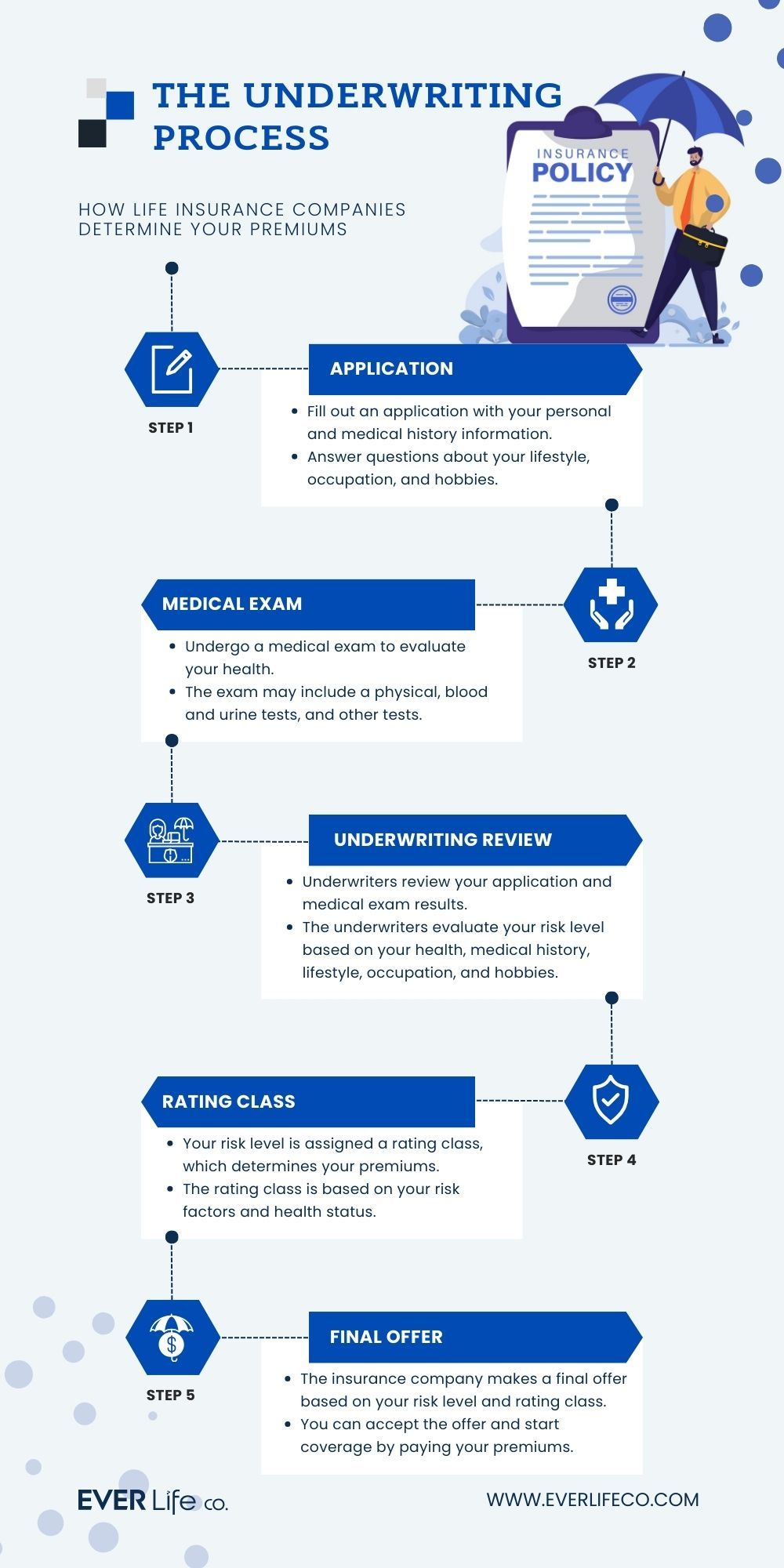Insurance underwriting is critical in the insurance industry in determining the risk of insuring a particular individual or entity. Insurers want to ensure they are taking an acceptable level of risk and can pay claims if they occur.
In this blog, we’ll examine the world of insurance underwriting, exploring the process and the factors that affect the outcome. Whether you’re an individual looking for insurance coverage or a professional in the industry, understanding the basics of underwriting is essential.
What Is Life Insurance Underwriting?
To calculate the risk of insuring a particular individual, life insurance companies apply a process called underwriting. This procedure includes evaluating the applicant’s medical history, lifestyle, occupation, and other factors to assess the likelihood that the individual will die while the policy is in effect.
Based on this assessment, the insurance company will either approve or deny the application or offer coverage at a higher or lower premium. Underwriting ensures the insurance company can pay death benefits if beneficiaries file for a claim.
What Is an Insurance Underwriter?
An insurance underwriter is a professional who carries out the review and evaluation of applicants. They examine and verify the applicant’s information to decide if the individual is eligible for a policy and the most feasible rates and conditions.
Insurance, like any other business, operates to make a profit. Underwriters help their respective insurance companies minimize their financial risk and protect them from potential losses.
Potential clients who present the least risk will almost always receive preferential treatment for the premiums charged and the conditions or exclusions included in their policy. The higher the risk an applicant presents, the lower the chance of favorable terms and rates.
What’s the difference between an underwriter, an agent, and a broker?
Underwriters, agents, and brokers are insurance professionals who play different roles in the industry.
- An underwriter is an employee of an insurer who evaluates the risk of insuring a particular individual or entity and determines the premium and coverage for policy contracts.
- An insurance agent is an individual who represents a single company (or multiple if they are independent) and sells its policies to clients. They typically receive payment by commission.
- A broker represents the client, not the insurer. They sell policies from multiple insurance companies and work to find the best coverage and price for the client. Brokers are usually paid a fee or by commission.
The Insurance Underwriting Process (How it Works + What to Expect)
Insurance underwriting is a sophisticated task that demands a high level of expertise and knowledge of risk assessment. Underwriters thoroughly understand the potential risks involved in insuring a potential customer and the means to mitigate them.
Underwriting a policy might vary across different companies and the type of insurance you apply for, but there are common steps.
1. Application for Coverage
The overall process starts when you fill out your life insurance application. The form includes questions covering basic health information and lifestyle habits—if you’re a smoker, how much you drink, do you engage in any extreme sports, and if you regularly exercise.
There’s also a section to provide information about your family history of genetic diseases like diabetes, heart disease, and history of cancer.
Other sections include the following:
- Financial information
- Current employment (dangerous occupations are factors considered in the approval process)
Complete your application with all the required information and be honest about your medical conditions to the best of your ability. Misrepresentations on your application can affect your approval for coverage or your beneficiary’s payout of death benefits.
2. Medical Exam and Report
Insurers will often ask for a medical to verify the information on your application. This examination is free, and your general doctor can’t conduct the medical. The insurer will inform you how to complete the exam, which may require a trip to a designated lab or a home visit from a medical technician.
The examiner will assess your medical history, lifestyle, and other risk factors during the insurance medical exam. Standard testing includes blood pressure, cholesterol, blood sugar levels, and height and weight measurements. They may also require blood and urine samples to check for drug use and verify your current medications.
The complexity of the exam depends on the applicant.
Other tests may also be conducted, depending on the individual’s age and potential health issues. The results of these tests estimate the applicant’s risk of dying while the insurance policy is in effect.
The underwriter will receive the results of the medical exam. You can also obtain a copy and apply for other types of coverage, such as disability or a life policy, from another provider within six months of its issuing. It’s important to note that you’re not obligated to accept a life insurance policy from the company that paid for the medical exam. You can shop around for the best terms and coverage for your needs.
You’d skip this medical portion if you applied for a guaranteed issue policy or if a health exam isn’t part of the application process.
3. Evaluation of Your Information
The underwriting process begins once you’ve sent in your application for coverage. The company will assign an underwriter who’ll build a risk profile based on the information in your application and your medical exam results.
During the application evaluation, the underwriter will:
- Review your application, highlighting common risk factors that may increase the chance of your filing an insurance claim.
- Determine whether you’re an acceptable investment risk and if the insurer should accept you as a customer. Your previous claims history will be part of the evaluation.
- Make recommendations about the policy type, terms, and conditions the company should include in the policy.
- Recommend solutions to reduce the chance and frequency of you filing future claims. These recommendations will reflect in the negotiation between the underwriter and your agent/broker as they work to settle on your insurance coverage.
Here’s a more detailed breakdown of specific steps the underwriter might take, depending on the company’s process.
MIB Verification
Underwriters will use the Medical Information Bureau (MIB) to check your medical records from previous life insurance applications. The sharing of medical data helps companies defend themselves against insurance fraud. It also allows underwriters to review details about any medical impairments, treatments, and diagnoses reported by previous underwriters from three to five years prior.
Any information revealed in the MIB check will not negatively impact your classification, as its purpose is to help identify any information previous evaluations missed.
Additional Health Status Follow-ups
If the underwriter notes any ambiguities or concerns about your insurer-issued medical, they’ll ask for a statement from your doctor. This statement, called an Attending Physician Statement (APS), summarizes your health history and current health conditions.
Additional follow-ups can add time to the underwriting process as the underwriter waits for the information from your doctor. The underwriter will also verify your prescription history.
Review of Your Driving History
A poor driving record will weigh heavily against you. The underwriter will request a motor vehicle report and check it for red flags like traffic violations, citations, and accidents.
Underwriters evaluate your life expectancy. Like risky occupations and severe health issues, a risky driving history means you’re a high-risk client. This heightened risk will reflect in either a high premium or denial of coverage.
Conversely, a clean driving record is advantageous and can help you unlock competitive rates and affordable premiums.
Note: Underwriters use their discretion based on company guidelines when assessing potential concerns about your health history. They might give you credit or points if they see that you are managing your preexisting condition effectively.
Risk Classification
After reviewing your information, the underwriter will assign a risk classification. This “grade” summarizes the risk you pose to the insurance carrier. Where you fall on this scale determines your insurance premium and terms.
There are four main tiers: Preferred Plus, Preferred, Standard Plus, and Standard. Here’s what they mean and how they affect your premium.
1. Preffered Plus (Super Preffered)
To qualify for the preferred plus (sometimes called super preferred) class, applicants must have excellent health, not engage in risky activities, or have a dangerous job. Furthermore, they must not have used tobacco in the past five years or misused drugs or alcohol in the past decade.
Additionally, they must not have a family medical history of cancer, heart disease, or a parent who died from cancer or cardiovascular disease before age 60 or 65.
The minority of applicants accepted at this tier will have the lowest premiums. They pose the lowest mortality risk; life insurance companies will reward them.
2. Preferred
People in the preferred risk class have similar profiles as super preferred. Still, they may have minor health issues and conditions such as high blood pressure, being overweight, or having a family history of risk. If you have diabetes or other conditions like depression or anxiety, you can still qualify if you take medication to manage them.
Premiums for this risk class will be higher than Preferred Plus.
3. Standard Plus
Most applicants fall into the standard risk classification. They usually have a higher body mass index (BMI), take multiple medications, or have potential health issues. They don’t require stellar driving records, and some riskier occupations, such as aviation, are still acceptable at this tier.
The standard risk classification is also more lenient regarding smoking; typically, you must be tobacco-free for one year (rather than five). Depending on the company, marijuana users may also qualify for the standard class.
Following Preferred’s trend, your life insurance rate and premium go up in this risk class.
4. Standard
Insurers use a table rating system to classify those with significant health conditions, such as past alcohol abuse, severe asthma, bipolar disorder, epilepsy, multiple sclerosis, and Type 1 diabetes.
People with specific impairments face a higher rate of denial of life insurance coverage. These factors include current alcohol abuse, cirrhosis, current cancer treatment, drug use, recent heart attack, HIV, kidney dialysis, mental illness hospitalization in the past year, and suicide attempt.
If approved, premiums will be considerably higher than all the other tiers because of the heightened risks to insurers.

Conclusion
Life insurance underwriting is a vital part of the insurance process. It helps insurance companies accurately assess the risk of insuring a particular individual and determine the best coverage option.
As an applicant, understanding the process is also essential to know how it works and how it affects your coverage. According to a study by LIMRA and Life Happens, 62% of consumers who considered themselves knowledgeable about insurance bought coverage. Be counted among the knowledgeable and those who feel financially secure with adequate life insurance coverage.






